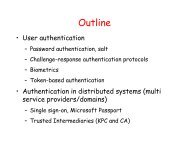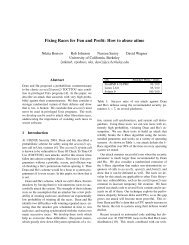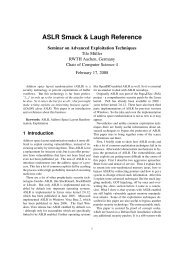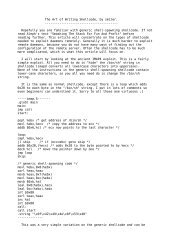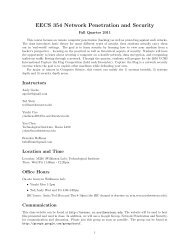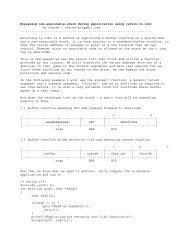Advanced Return to libc Exploits
Advanced Return to libc Exploits
Advanced Return to libc Exploits
Create successful ePaper yourself
Turn your PDF publications into a flip-book with our unique Google optimized e-Paper software.
inconsistent state in the DTLB and ITLB entries.[...] this very same<br />
mechanism would allow for creating another kind of inconsistent state<br />
where only data read/write accesses would be allowed and code execution<br />
prohibited. and this is what is needed for protecting against (many)<br />
buffer overflow based attacks."<br />
To sum up, a buffer overflow exploit usually tries <strong>to</strong> run code smuggled<br />
within some data passed <strong>to</strong> the attacked process. The main PaX functionality<br />
is <strong>to</strong> disallow execution of all data areas - thus PaX renders typical<br />
exploit techniques useless.<br />
--[ 4.2 - PaX and return-in<strong>to</strong>-lib exploits<br />
Initially, non-executable data areas was the only feature of PaX. As<br />
you may have already guessed, it is not enough <strong>to</strong> s<strong>to</strong>p return-in<strong>to</strong>-lib<br />
exploits. Such exploits run code located within libraries or binary itself -<br />
the perfectly "legitimate" code. Using techniques described in chapter 3,<br />
one is able <strong>to</strong> run multiple library functions, which is usually more than<br />
enough <strong>to</strong> take advantage of the exploited program's privileges.<br />
Even worse, the following code will run successfully on a PaX protected<br />
system:<br />
char shellcode[] = "arbitrary code here";<br />
mmap(0xaa011000, some_length, PROT_EXEC|PROT_READ|PROT_WRITE,<br />
MAP_FIXED|MAP_PRIVATE|MAP_ANON, -1, some_offset);<br />
strcpy(0xaa011000+1, shellcode);<br />
return in<strong>to</strong> 0xaa011000+1;<br />
A quick explanation: mmap call will allocate a memory region at<br />
0xaa011000. It is not related <strong>to</strong> any file object, thanks <strong>to</strong> the MAP_ANON<br />
flag, combined with the file descrip<strong>to</strong>r equal <strong>to</strong> -1. The code located at<br />
0xaa011000 can be executed even on PaX (because PROT_EXEC was set in mmap<br />
arguments). As we see, the arbitrary code placed in "shellcode" will be<br />
executed.<br />
Time for code examples. The attached file vuln.c is a simple program<br />
with an obvious stack overflow. Compile it with:<br />
$ gcc -o vuln-omit -fomit-frame-pointer vuln.c<br />
$ gcc -o vuln vuln.c<br />
The attached files, ex-move.c and ex-frames.c, are the exploits for<br />
vuln-omit and vuln binaries, respectively. <strong>Exploits</strong> attempt <strong>to</strong> run a<br />
sequence of strcpy() and mmap() calls. Consult the comments in the<br />
README.code for further instructions.<br />
If you plan <strong>to</strong> test these exploits on a system protected with recent<br />
version of PaX, you have <strong>to</strong> disable randomizing of mmap base with<br />
$ chpax -r vuln; chpax -r vuln-omit<br />
----[ 4.3 - PaX and mmap base randomization<br />
In order <strong>to</strong> combat return-in<strong>to</strong>-lib(c) exploits, a cute feature was<br />
added <strong>to</strong> PaX. If the appropriate option (CONFIG_PAX_RANDMMAP) is set during




